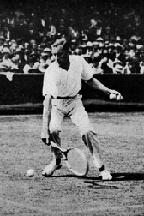|
TennisOne Lessons
Bill Tilden and the Classical Vision, Part Two:
Tilden Versus Bollettieri by Kim Shanley The Greeks first defined the classic vision of grace, balance, and the Golden Mean (nothing to extreme). The Greeks, inventors of philosophy, also believed that a man's life should be directed by clear ideas.--from Part 1, Bill Tilden and the Classical Vision Talking about Greek philosophy may be a strange way to start talking about winning tennis matches. But it wouldn't have seemed strange to Tilden, one of the great theorists of the game who thought of tennis as a science and an art. Like the Greeks, Tilden had a deeply rooted feeling for balance, that a great tennis player must have all the skills for both offense and defense. Attack alone, or defense alone, is not enough; a combination of the two, with the knowledge of how to employ them, is what makes your...Donald Budge, or Bobby Riggs....the incontrovertible lesson that the combination of attack and defense, the proper blend, is the maximum in tennis skills.Here Tilden is posing a fundamental disagreement with the style and philosophy of the modern game of tennis. Power, speed, and offense dominate the modern game. Huge serves, blistering forehands, rocketing winners from impossible angles--it's-big-babe, don't-wait-for-your-opponent-to-miss-run-around-your-forehand-bang-the-hell-out-of-it-tennis. Of course I'm exaggerating a bit, but not much. Listen to the style and substance of Nick Bollettieri, the brash spokesperson for the brash, hyper-aggressive philosophy of today's game. In Bollettieri's 1996 autobiography, "My Aces, My Faults," his co-author, Dick Schaap, titles the first chapter, "Everything to Excess." (Remember the classical Golden Rule: Nothing to Excess?) How good a coach is Bolletieri? In the last chapter of his book, Bollettieri sums it up for us. "I know I am the best tennis coach in the world. I have no doubts about that." How influential is Bollettieri? He nurtured or honed the all-out attacking game of Agassi, Courier, Pierce and Seles. Most recently, he coached Mark "The Scud" Philippoussis. To be fair, over the years Bollettieri--and even by his own admission--has gained a much better grasp of overall strategy and the nuances of the game. But the trademark of the Bollettieri's school of tennis is hyper-aggressiveness. [Number 6 tip for better return of serve] Don't be hesitant. Be bold and GO FOR IT! [Nick's last words of advice] Practice mental reinforcement. Say to yourself, "I am going to hit the heck out of the ball." Lastly, remember that breaking serve is one of the best ways to improve your own serve. Go for it! Tilden's classical view of the game is that man--particularly the average club player--is a fallible creature playing a sport more liable to expose his fallibility than demonstrate his perfection: Remember that in first-class tournament tennis, 70 percent of all points end in error....and only 30 percent end in winning placements or service aces...(of course, the percentage of points ending in an error is even higher in poorer caliber tennis). This fact gives birth to the first great rule in general tactics: keep the ball in play and give your opponent another shot at it, rather than risk an error by taking an unnecessary chance.Bollettieri's basic orientation is just the opposite of Tilden's classical view. In his September, 1996 "How to End the Point" piece in Tennis Magazine , he begins with an impatient dismissal of defensive tactics. How do you end a point? Do you pray for your opponent to miss, because you simply don't know how to end the point yourself? Most players just wait for the other person to make an error. Sure, that can work some of the time, but you need to have a plan that lets you win the point most of the time.One could make a good argument that in today's professional tennis, big athletes and power racquets, have fundamentally changed the game to favor aggressive, first strike tactics. I believe Tilden, a realist, would have recognized this shift and given it its proper due, but I can't help but think he would still express his reservations. In his last book published shortly before his death in 1953, Tilden commented, "There are some very valuable things of the past that have been lost in the wild scramble for speed and power." What has been lost? How about tennis itself? Certainly at Wimbledon, the premier showcase for tennis, matches can last for two or three hours but the time players actually spent hitting balls back and forth over the net (you know, the fun stuff) often is a small percentage of the time on court. Well, this is a familiar argument, and the familiar come-back is that's only true when the big hitters play and only true at Wimbledon. Maybe, maybe not. This is not the place to try to settle that debate (but I think it's hard to argue that while there still may be excitement in witnessing a 137 m.p.h. ace, there isn't much drama). |

